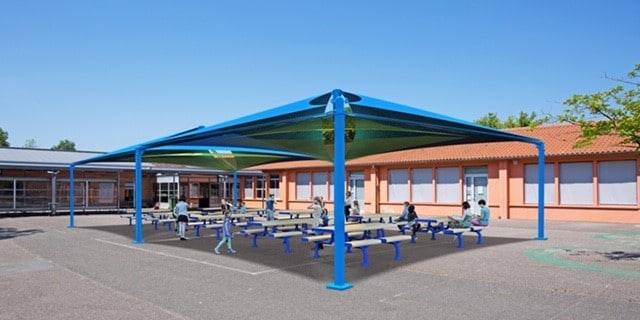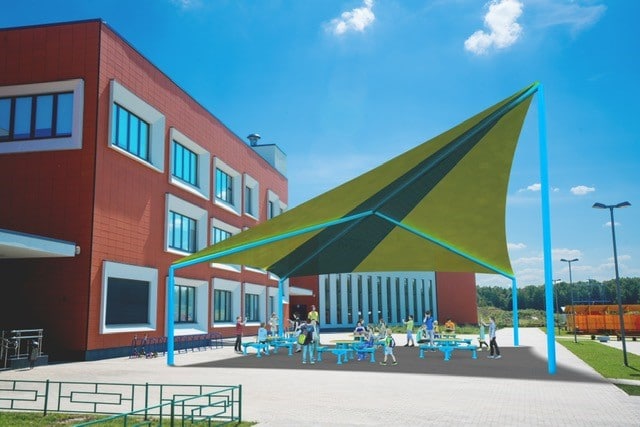In a previous blog post, we examined the case for outdoor classrooms and why this fall is the perfect time to consider outdoor classroom ideas for your school district. Now, let’s take a look at the practical considerations in deciding whether your district can implement outdoor classrooms.
Where could you put an outdoor classroom?
This seems like the best place to start an exploration of outdoor learning ideas. Fortunately, an outdoor learning space can be tucked almost anywhere: in existing gardens, on lawns, in courtyards, even over asphalt (now that many districts are limiting visitors, unused parking lots, anyone?). Campuses without a lot of extra outdoor space may want to consider inquiring about using nearby parks. The main calculation is to determine how many square feet your classroom should be, taking into consideration average class size and social distancing needs.
What exactly would you need?
The design of any learning space is likely to be contingent on the location. While a few hay bales for seating could suffice for a preschool reading class under a spreading oak tree, the needs will be different for an elementary school biology class in the gardens or a conversational foreign-language class in a corner of the high school parking lot.

That said, almost any class that can take place indoors can be considered for class outdoors, if you plan for the following:
- Seating: Just like in an indoor classroom, having comfortable and appropriately sized seating is important to keeping students interested and engaged. Portable tables and benches can provide flexibility while surface mount benches and tables offer a more permanent solution.
- Shade: Shade canopies can be configured in a variety of ways to provide crucial protection from the elements. Today’s long-wearing shade fabrics block up to 98 percent of the sun’s harmful UV rays and keep the surfaces they protect up to 20 degrees cooler – and the cooler children are, the easier it will be to focus on outdoor learning.
- Safety: The usual requirements must be modified for outdoor purposes, including a plan for inclement weather. For preschool and elementary school outdoor classrooms, there will likely need to be restrictions around students leaving the class area or playing with sticks, insects, etc.
- Storage: Teachers will need a place nearby to store their teaching aids and class supplies – and probably also a way to easily transport items back and forth. Depending on classroom location, this could be anything from inside storage closets to outdoor storage sheds. You’ll also want to have extra trash and recycling receptacles nearby.
- Self-directed learning: Part of the benefit of being outside is to increase students’ opportunities to actively participate in decisions about their own learning. These decisions could include anything from the practical activities of growing food to meteorological observations to finding exactly the floral inspiration they need for art class.
Who will staff your outdoor classrooms?
Now we come to another complication school districts are facing this fall: Socially distanced classrooms can mean a need for more teaching staff as the teacher-to-student ratio drops. One suggestion is to find a way to involve outdoor educators who may be available due to closures caused by the pandemic. This includes workers from national parks, museums, science centers, and other learning locations. For example, the Lawrence Hall of Science conducted a survey of the nonformal education sector in April; close to 1,000 organizations from 49 states and the District of Columbia responded, and they expected to furlough 30,000 staff members through the end of this calendar year.

How often should outdoor classrooms be used?
As referenced above, the weather could play an important role in this question, even in a fairly temperate zone like Texas. Much like schools have rainy-day policies for taking recess indoors, each campus with an outdoor classroom would need a plan for where to hold class in the event of bad weather.
However, weather permitting, outdoor learning spaces could be used anywhere from one or two class periods a week to being scheduled for every period, every day. The exact schedule would depend on the needs of each campus and the number of classes that could reasonably transition outside.
Speaking of time frames this fall, have you heard of the annual Outdoor Classroom Day? This fall’s international celebration is scheduled for Nov. 5. Its creators remind us that, even before the coronavirus pandemic, over half of children worldwide were spending less than an hour outside every day, even though time outside can have a profound impact on their physical and mental health. Your district – and your students — may benefit from experimenting with outdoor learning options on that day, if not sooner.
Getting the Input You Need
“Obviously, transitioning to [outdoor classrooms] comes with challenges in terms of liability, curriculum flexibility and so on,” observed reporter Ginia Bellafante in her New York Times article on the history of outdoor classes. “But the reality of losing a generation of students to the deficiencies of Zoom seems much more troubling.”
If you’re interested in getting more concrete advice on how your district could set up outdoor classrooms on any of its campuses, contact us at Park Place Recreation Designs. We are a commercial-grade park & playground equipment consulting & design firm with 35+ years of experience providing South Texas with safe, durable and competitively priced equipment designed to address children’s developmental needs. We can put our extensive knowledge and creativity toward any questions you have and adapt any space to meet both your outdoor learning needs and the requirements of your budget. Park Place is a TXMAS-approved vendor and a member of the Buyboard, and we can provide a “Buy American” certificate for anyone purchasing equipment under the American Recovery & Reinvestment Act.
